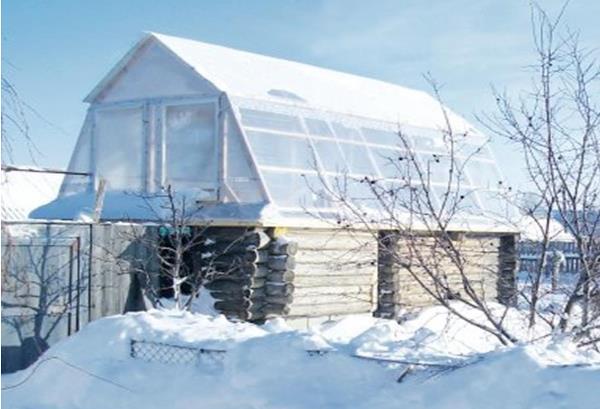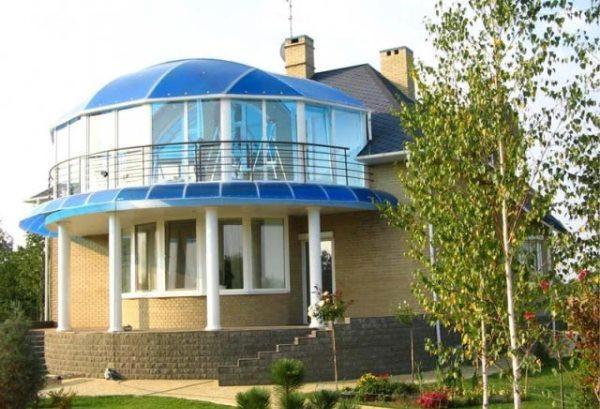We install a greenhouse on the roof or attic of the house
Often the owners of summer cottages are worried about saving territory. Placing a greenhouse on the roof of an outbuilding will be a good solution to this summer cottage problem. And even better - arrange it right in the attic of the house.



The economic benefits of a rooftop greenhouse
Such a solution will help the owner of the cottage to solve many issues:
- This is an additional protection against precipitation of the roof of the building.
- The organization of a greenhouse in the attic will increase the thermal insulation of the house.
- Heat loss, which is almost impossible to get rid of completely, will be used expediently.
- Saving land on the site will allow you to grow more crops. And if the seedlings were previously grown in a room on the windowsill, then moving the boxes to the greenhouse will make life more comfortable and the house cleaner.
- Carbon dioxide rising from living quarters is necessary for gas exchange and photosynthesis of plants.
- There is no need to spend money on lighting, because the access of light to the plants is ensured throughout the day - trees and buildings do not interfere with the development of plants, since the structure rises above everything that gives shade on a sunny day.
- Placing a greenhouse on the roof, the owner saves on the foundation, communications for water supply, heating and ventilation.
An important factor is the fact that the greenhouse, located on the ground, is in direct contact with the soil in early spring, when it is still completely frozen. There is no such problem on the roof. Therefore, the roots of the plants receive more heat and the seeds germinate faster.

Methods for equipping a greenhouse on the roof
There are several options for organizing this know-how.
Type "Second roof"
Directly on the building itself, a greenhouse is equipped, using the roof as its foundation, in the event that it is not sloping. To do this, you will need to finish building the walls up. It is best to make them with a transparent material such as glass. You should also take care of the second roof, which, like walls, allows light to pass through.
You can also use the second option: make the second gable or shed roof. Of course, working in such a greenhouse will not be as comfortable as where the walls have been built up, but economically, this option wins.

Attic type of greenhouse
This option consists in the fact that the owner simply remakes the roof itself, replacing it with a transparent one. Boxes with soil and plants are installed in the attic.
It is important to remember that each building has its own purpose. And if the attic in the house was equipped with the expectation to play the role of only a mezzanine for storing rarely used items with low weight, then it is quite possible that it will not be able to withstand the load that is intended for a greenhouse.
Therefore, it is necessary to strengthen the supporting beams, the floor itself. There is another option: to lay a new floor in the attic, taking it outside a little further than the walls. Its edges need to be installed on new support posts. Then the greenhouse will not create additional load on the walls and ceiling of the building.

If the house was originally planned as a building with an attic, which it was decided to use as a greenhouse, then there should be practically no problems with re-equipment.
Roof or attic greenhouse planned prior to building construction
It is optimal to provide for the equipment of the greenhouse in advance even before the start of the construction of the house or outbuilding. Indeed, in this case, during the preparation of the project, it is possible to calculate the load-bearing capacity of the floor so that subsequently there is no sagging of the beams and the occurrence of other undesirable moments.

Rooftop greenhouse equipment
The owner who decides on this know-how should take care of such factors as:
- greenhouse water supply;
- waterproofing the floor;
- ventilation;
- light flow control.
Water supply
The greenhouse needs water, because the plants require constant glaze... You can, of course, carry it upstairs in buckets, although it's hard. But in any case, care must be taken to ensure that the ladder to the greenhouse is comfortable and durable.

It is best, of course, to lead the water upstairs. This is not so difficult to do if the house itself already has running water.
If there is water only in the column, the activation of which is impossible to manipulate while in the greenhouse, then you can put some container there, which you fill with a watering hose, and then water the plants from it.
Waterproofing
And here the question arises: what can happen if suddenly the hose breaks or is pushed out of the tank, the container of water itself tilts over or simply begins to slowly leak imperceptibly? The answer is not optimistic. Therefore, it is important to take care of the waterproofing of the greenhouse floor.

You can coat it with hot bitumen mastic. There is another option: lay out roll waterproofing on it.
Ventilation
It should be borne in mind that warm air always rises. Therefore, the temperature in the greenhouse will be much higher than if it were on the ground. Consequently, the problem of its ventilation is far from the last.

It is necessary to make as many vents in the greenhouse as possible. Doors on both ends will also help regulate the room temperature. You can even install a thermostat inside, which will either automatically open the vents and doors, or inform the owner that it is time to ventilate the greenhouse.
Light mode control
Plants at different stages of life require a different amount of sunlight.
In order to predictably manage fruiting, a set of green mass, flowering, a person artificially lengthens or shortens daylight hours. You can achieve this in a greenhouse if you think over all the options in advance.

The easiest ways to shorten the day are to install an umbrella type or curtain walls and shade the roof. And you can lengthen it, including special ultraviolet lampsintended for seedlings.